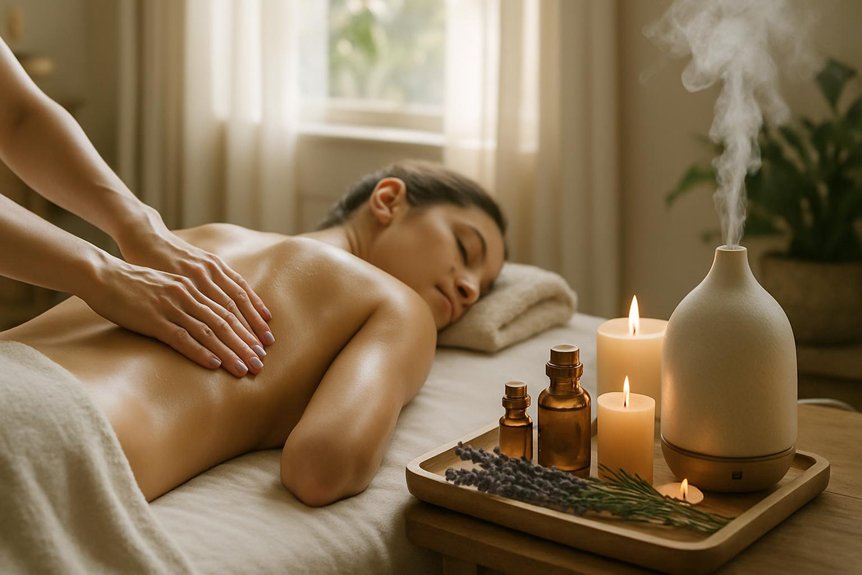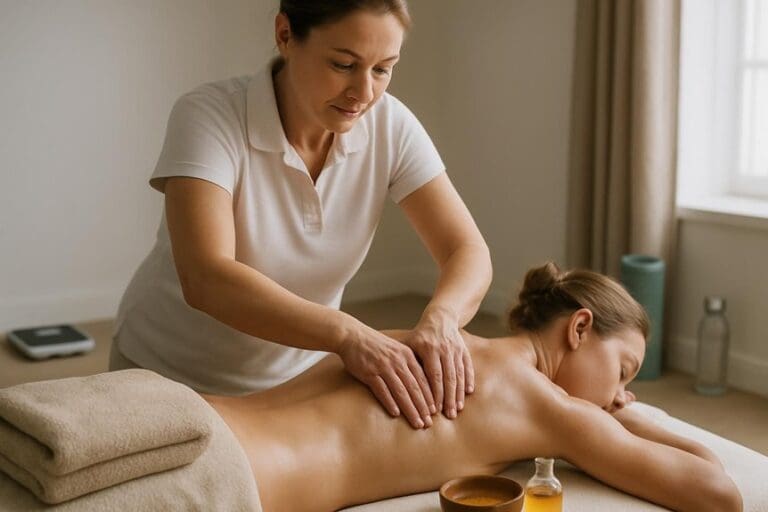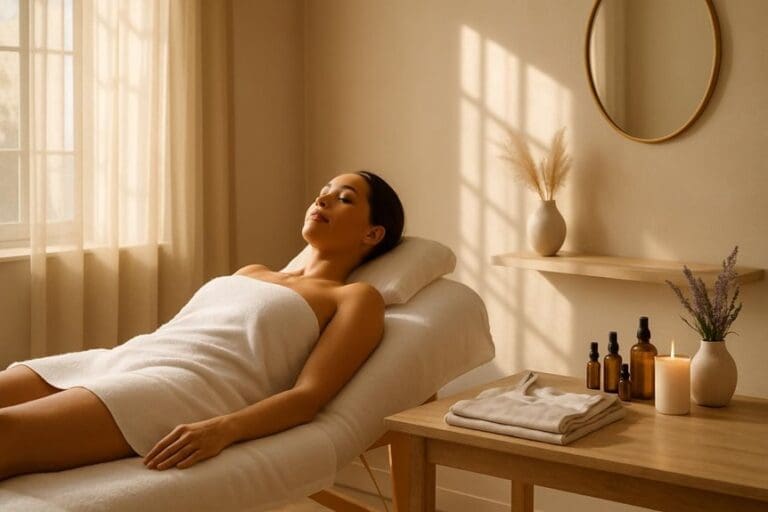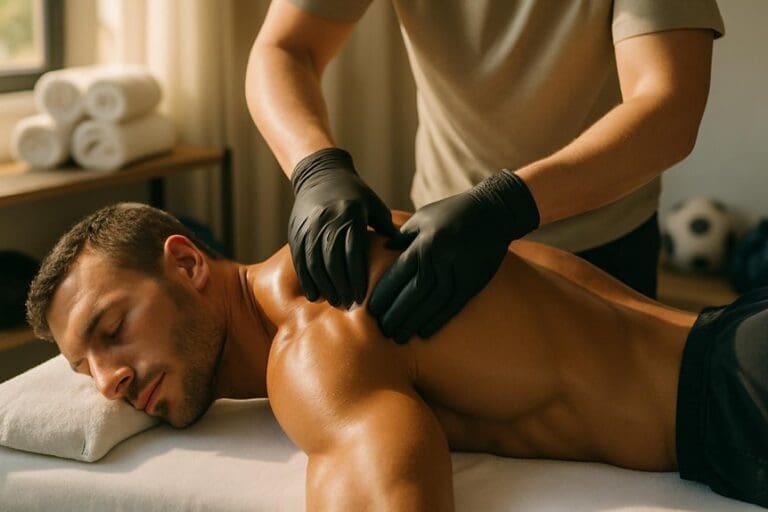Aromatic massage is used to promote relaxation, reduce stress, alleviate muscle tension, and support emotional wellbeing through the combined action of manual therapy and essential oils. Clinical evidence indicates benefits such as enhanced sleep quality, improved circulation, and reduction in headache frequency. Essential oils like lavender and eucalyptus are selected for their anxiolytic, analgesic, or anti-inflammatory properties. Sessions can also support skin health and immune function. Further information reveals the range of therapeutic effects and personalization strategies involved.
Enhancing Relaxation and Reducing Stress
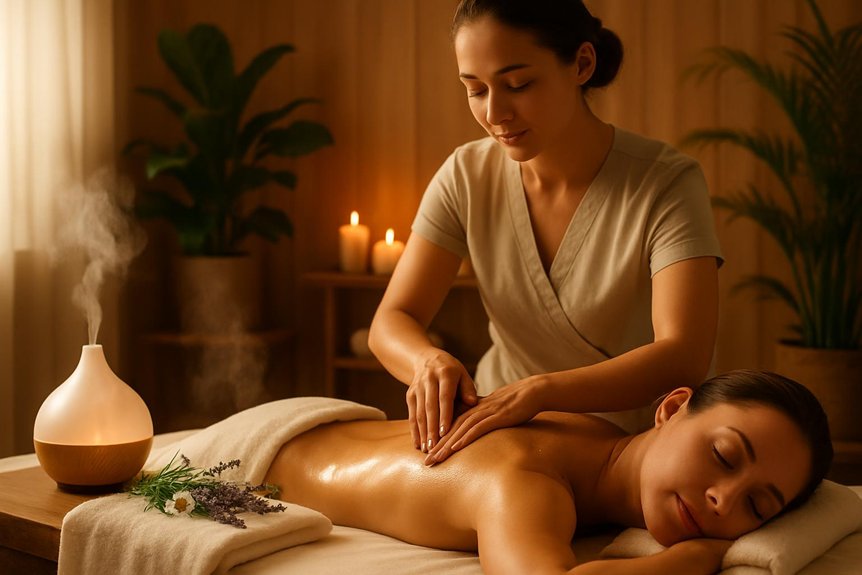
How does aromatherapy massage facilitate relaxation and mitigate stress responses? Aromatic massage at Spa & Massage integrates targeted manual therapy with the application of essential oils, selected for their documented anxiolytic and calming properties.
During treatment, therapeutic touch stimulates the parasympathetic nervous system, lowering heart rate and blood pressure. Inhalation and dermal absorption of essential oils—such as lavender or chamomile—modulate neurochemical pathways associated with stress regulation.
This dual action attenuates cortisol levels and elicits a profound relaxation response. In-clinic protocols emphasize gentle, rhythmic strokes tailored to individual sensitivity, creating a deeply comforting environment.
Clients frequently report a significant reduction in muscular tension and a pervasive sense of tranquility, reflecting the evidence-based efficacy of essential oil massage for immediate and sustained stress reduction. While aromatherapy is distinct from the healing power of reflexology, both therapies share a focus on holistic well-being and can be complementary in reducing stress and enhancing relaxation.
Supporting Emotional Wellbeing
Why does aromatic massage exert such a notable influence on emotional wellbeing? Clinical research indicates that the olfactory system directly impacts limbic brain regions involved in mood regulation.
During this massage at Spa & Massage clinics, carefully selected essential oils—such as lavender, bergamot, or geranium—are chosen for their anxiolytic and mood-balancing properties.
The tactile element of therapeutic massage, combined with aromatic stimulation, facilitates parasympathetic nervous system activation, thereby reducing cortisol levels and promoting emotional equilibrium.
Many clients report enhanced emotional clarity and a greater sense of connectedness following their sessions.
Our therapists employ evidence-based approaches, ensuring each treatment is attuned to individual psychological needs.
This integrative method supports those seeking solace, balance, and lasting emotional resilience within a nurturing, confidential environment.
Relieving Muscle Tension and Physical Discomfort
This type of massage is an effective intervention for alleviating muscle tension and physical discomfort, as demonstrated by both clinical studies and client outcomes at Spa & Massage clinics. This approach integrates targeted manual techniques with carefully selected essential oils known for their analgesic and anti-inflammatory properties.
Skilled therapists apply tailored pressure to areas of tension, facilitating myofascial release and promoting increased local circulation. Essential oils such as lavender, eucalyptus, and ginger are frequently used in our clinics to support muscular relaxation and comfort.
The synergy of touch and aromatic compounds enhances the body’s natural healing response, reducing soreness and stiffness. Clients consistently report a tangible decrease in musculoskeletal discomfort and improved range of motion following sessions, underscoring aromatic massage’s role in holistic physical care.
Improving Sleep Quality
Many individuals seeking to address sleep disturbances find that massage therapy incorporating essential oils can meaningfully enhance sleep quality.
Aromatic massage employs sedative and anxiolytic essential oils—such as lavender or chamomile—blended by skilled therapists to promote relaxation and reduce hyperarousal.
At Spa & Massage, therapists tailor oil selection and massage techniques to encourage parasympathetic nervous system dominance, facilitating the body’s natural progression into restful states.
Clinical evidence supports the efficacy of essential oil massage in reducing sleep latency and improving overall sleep duration and quality.
Clients often report a sense of tranquility and emotional comfort after sessions, which can counteract insomnia or fragmented sleep patterns.
For ideal results, therapists at Spa & Massage recommend a regular schedule, fostering cumulative benefits for restorative sleep.
Boosting Circulation and Lymphatic Flow
Aromatic massage may enhance peripheral circulation and lymphatic flow through the combined effects of targeted manual techniques and specific essential oils known for their vasoactive properties.
At Spa & Massage, therapists utilize gentle, rhythmic strokes and lymphatic drainage maneuvers to facilitate the movement of blood and lymph, supporting tissue oxygenation and metabolic waste removal.
Clinical evidence suggests this approach can contribute to reduced swelling, improved tissue health, and a greater sense of bodily vigor.
Essential Oils and Blood Flow
The application of select essential oils during massage has been shown to enhance peripheral blood circulation and stimulate lymphatic flow. Essential oils such as rosemary, black pepper, and ginger are frequently incorporated at Spa & Massage clinics for their vasodilatory effects, which facilitate improved oxygen and nutrient delivery to tissues.
Clinical studies suggest these oils, when absorbed through the skin and combined with targeted massage techniques, may reduce localised muscle tension and promote a gentle warming sensation. This process not only supports circulatory efficiency but also encourages a subtle sense of bodily connectedness.
For individuals seeking a more intimate and responsive massage experience, the thoughtful integration of essential oils helps to optimise both physiological benefits and the overall sensory experience, tailored to each client’s needs.
Lymphatic Drainage Techniques
Building upon the circulatory benefits conferred by specific essential oils, lymphatic drainage techniques are frequently integrated at Spa & Massage clinics to further enhance systemic detoxification and fluid balance.
These gentle, rhythmic movements are designed to stimulate lymphatic vessels, promoting the removal of metabolic waste and excess fluid from tissues. Spa & Massage therapists employ precise, light-pressure strokes—often in a proximal to distal sequence—to facilitate lymph flow, reduce oedema, and support immune function.
Aromatherapeutic blends, carefully selected for their anti-inflammatory and decongestant properties, complement the manual techniques, heightening therapeutic efficacy. Many clients report a sensation of lightness, diminished bloating, and profound relaxation following treatment.
This evidence-based approach underscores Spa & Massage’s dedication to holistic wellness, ensuring each experience is both medically sound and deeply nurturing.
Supporting Immune System Function
While the immune system’s efficiency is influenced by numerous physiological factors, targeted therapies such as aromatic massage may contribute positively to immune function.
In Spa & Massage clinics, therapists often select essential oils known for their immunomodulatory properties, such as eucalyptus or tea tree, chosen specifically to complement each client’s needs. These oils, when combined with gentle, rhythmic massage techniques, can support lymphatic circulation and reduce stress-related immunosuppression.
Evidence suggests that regular essential oil massage sessions may reduce cortisol levels, promoting an internal environment conducive to immune resilience. Clients frequently report a sense of warmth and wellbeing after their sessions, reflecting potential enhancement in systemic balance.
Spa & Massage’s tailored approach ensures every treatment supports both relaxation and the body’s natural defense mechanisms.
Alleviating Headaches and Migraines
This massage may contribute to headache and migraine relief through the application of specific essential oils known for their analgesic and anti-inflammatory properties, such as lavender and peppermint.
At Spa & Massage, therapists employ targeted massage techniques focusing on the scalp, neck, and shoulders to help reduce muscular tension commonly associated with headache disorders.
Clinical evidence suggests that this integrative approach can support symptomatic relief and promote overall relaxation.
Essential Oils for Relief
The targeted application of essential oils, particularly those with analgesic and anti-inflammatory properties, offers measurable relief from headaches and migraines. Clinical evidence highlights the efficacy of oils such as lavender, peppermint, and eucalyptus in modulating pain perception and reducing neurogenic inflammation.
At Spa & Massage, therapists select these oils based on individual client profiles and symptom presentation, ensuring a tailored, client-centered approach. When expertly incorporated into this kind of massage, these essential oils are absorbed via the skin and inhaled, engaging both local and systemic mechanisms.
This dual-action delivery promotes a soothing, therapeutic environment, fostering relief and relaxation. Many clients report decreased headache frequency and intensity following regular aromatherapy sessions, underscoring the value of precise essential oil selection in targeted headache management at Spa & Massage.
Massage Techniques for Headaches
Beyond the selection of targeted essential oils, specific massage techniques play a direct role in alleviating headaches and migraines. At Spa & Massage, therapists employ gentle, rhythmic effleurage along the scalp, temples, and neck to reduce muscular tension and enhance local circulation.
Targeted acupressure is applied at points such as the suboccipital region and along the trapezius, where tension commonly accumulates. Careful kneading of the upper back and shoulders further addresses postural contributors to headache pain.
These evidence-based methods, combined with mindful attention to client comfort and pressure preferences, support relaxation of both the nervous system and vascular structures implicated in headache pathophysiology.
Clients frequently report not only symptomatic relief but also a heightened sense of calm and personal connection fostered by therapeutic touch.
Promoting Skin Health and Nourishment
How does targeted massage therapy contribute to skin vitality and nourishment? Clinical research indicates that this massage, as practised at Spa & Massage, enhances cutaneous circulation, facilitating preferred oxygen and nutrient delivery to skin cells.
Gentle yet deliberate effleurage and petrissage techniques stimulate the lymphatic system, supporting detoxification and reducing fluid retention, which can lead to a brighter, healthier complexion. Additionally, the application of expertly selected, nutrient-rich massage oils at Spa & Massage provides emollient benefits, reinforcing the skin’s barrier function and improving hydration.
Essential oils, when properly diluted and massaged into the skin, may offer anti-inflammatory and antioxidant properties, further supporting epidermal repair and resilience. This results in a tactile sense of renewal and intimacy, fostering both visible radiance and enhanced skin comfort.
Personalising Wellness With Tailored Essential Oils
Why do individual needs and preferences play a pivotal role in aromatic massage outcomes? The efficacy of aromatic massage hinges on the precise selection of essential oils, which must conform to each client’s physiological and psychological profile.
At Spa & Massage, therapists conduct thorough consultations to assess health status, sensitivities, and desired therapeutic effects—whether relaxation, invigoration, or relief from tension.
Essential oils such as lavender, eucalyptus, or geranium are then blended to optimise benefits and minimise adverse reactions. This evidence-based, personalised approach guarantees that every session is both safe and deeply resonant, fostering a sense of intimacy and trust.
Conclusion
Aromatic massage offers a multifaceted approach to wellness, addressing both physiological and psychological concerns through the synergistic use of essential oils and therapeutic touch. Significantly, a 2020 meta-analysis found that aromatic massage reduced anxiety levels by up to 30% in clinical populations. This evidence underscores its efficacy as a complementary intervention for stress-related disorders. With tailored essential oil selection and expert application, essential oil massage remains a clinically relevant option for those seeking holistic health benefits.
